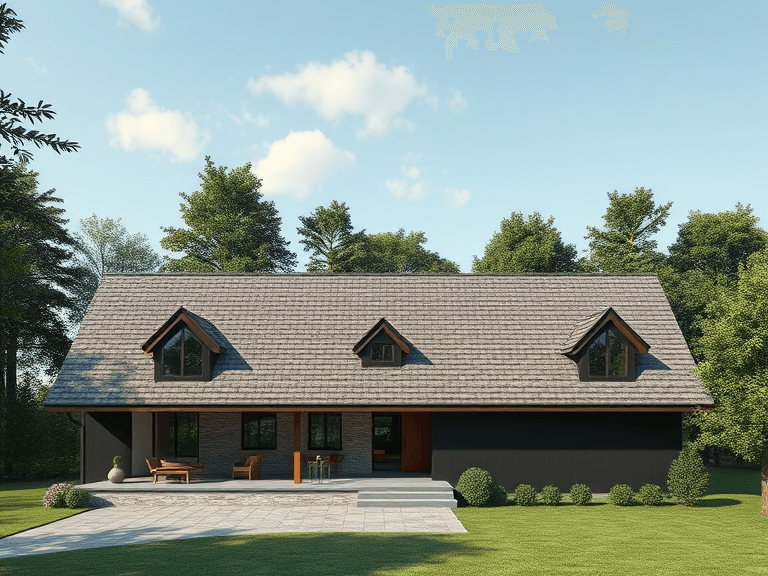
The choice of roofing materials is pivotal for homeowners when considering repairs or replacements. Several commonly used materials each have their unique attributes, advantages, and disadvantages. Among the most prevalent options are asphalt shingles, metal roofing, tile, and flat roofs.
Asphalt shingles are one of the most popular roofing materials, particularly within residential properties. They are favored for their affordability and ease of installation. Available in a range of colors and styles, asphalt shingles can last between 15 to 30 years, depending on the quality. However, they are susceptible to weather-related damage, particularly in regions with extreme temperatures or heavy storms.
In contrast, metal roofing offers enhanced durability and longevity, often exceeding 50 years with proper maintenance. These roofs can be made from a variety of metals, including steel, aluminum, and copper, providing an aesthetically pleasing option. Metal roofs reflect heat, which can contribute to energy efficiency. However, they tend to be more expensive initially, and the sound of rain on metal might be a concern for some homeowners.
Tile roofing, often associated with a classic appearance, comprises materials like clay or concrete. These roofs can last over 100 years and are highly resilient to fire and mold. Nevertheless, their weight necessitates a strong structural support, which could lead to higher installation costs. Additionally, they can be prone to cracking.
Lastly, flat roofs, commonly used in commercial settings, are often constructed from materials like rubber or modified bitumen. While they are less expensive and easier to maintain, flat roofs can be prone to pooling water, requiring diligent upkeep to prevent leaks. Understanding the properties of each roofing material is essential for homeowners, enabling informed decisions during repairs or replacements.
Identifying Roof Damage
Recognizing roof damage is a critical step in maintaining the integrity of a home. Homeowners should regularly inspect their roofs for various signs of deterioration. One of the most common indicators is the presence of leaks. Water stains on ceilings or walls typically suggest that your roof is compromised, possibly due to damaged shingles or faulty flashing. Prompt identification is key, as ignoring leaks can lead to more severe issues, including mold growth and structural damage.
Another significant sign of roof damage is missing shingles. Wind or severe weather can displace shingles, exposing underlying materials to the elements. Homeowners should actively check for shingle loss during regular inspections. Alongside this, discoloration on the roof surface can indicate mildew or algae growth, which not only affects visual appeal but can also impact roofing materials. Regular cleaning and upkeep can help mitigate these issues.
Sagging is another critical visual symptom of roof damage. A sagging roofline may result from compromised structural components or excessive weight from accumulated snow or debris. This type of defect often necessitates immediate professional evaluation. Homeowners are advised to inspect both the interior and exterior of their roofs, looking for signs of wear and tear. Interior signs include visible day light through the roof or gaps near the attic.
Regular inspections conducted at least twice a year, preferably in spring and fall, are essential for detecting these issues early. Additionally, routine checks after severe weather events can uncover damage that may not be immediately apparent. By being proactive and aware of the indicators of roof deterioration, homeowners can effectively safeguard their properties and determine when it is necessary to seek professional assistance.
Safety First: Preparing for Roof Repairs
Undertaking roof repairs can be a risky endeavor, making safety precautions paramount for any homeowner or professional involved in the process. Before climbing a ladder or stepping onto a roof, it is essential to be adequately prepared and equipped for performing roof repairs. The right safety gear serves as the first line of defense against accidents and injuries that may occur during these tasks.
A hard hat is an indispensable piece of safety equipment. It protects the head from falling debris, which can be a significant hazard, especially when working on older homes or during windy weather conditions. Additionally, non-slip shoes provide the grip needed to navigate often uneven or sloped surfaces safely. Investing in quality footwear will bolster one’s footing, reducing slips and falls that might otherwise result in serious injury.
Utilizing a harness system is another critical safety measure. A roofing harness can secure individuals while they work on elevated surfaces, providing the necessary support should they lose their balance. This harness should be appropriately anchored to a secure point on the roof. Moreover, it is vital to assess the condition of the roof prior to beginning repairs. The presence of wet or slick surfaces can exacerbate risks; therefore, workers should wait for dry conditions to ensure a safer environment for roof repairs.
Creating a secure work environment also involves checking tools and equipment before use. All ladders should be stable and placed on even ground, and all tools should be accounted for and regularly maintained. Additionally, informing others about the roofing project can help prevent accidental interference or injuries caused by unaware bystanders. By prioritizing the right safety measures, individuals can undertake roof repairs with the confidence that they are minimizing risk and enhancing their overall safety.

DIY vs. Hiring a Professional
When faced with roofing repairs, homeowners often find themselves at a crossroads: should they tackle the project as a do-it-yourself (DIY) venture or hire a professional contractor? Understanding the pros and cons of each approach is vital in making an informed decision that suits both the specific roof issues and the homeowner’s capabilities.
Engaging in DIY roof repairs can offer several advantages. Primarily, cost savings are a significant benefit, as homeowners can skip labor fees charged by professionals. Additionally, DIY projects can offer a sense of accomplishment and a hands-on experience. For those with adequate skills or previous experience in home repairs, smaller issues, such as patching leaks or replacing a few shingles, may be manageable. However, undertaking more complex repairs can pose significant risks, including safety hazards or the possibility of exacerbating the existing problem.
Conversely, hiring a professional roofing contractor brings a different set of advantages. Experienced roofers possess the skills and knowledge necessary to address a wide range of roofing problems efficiently. Their expertise ensures that repairs are executed correctly, reducing the likelihood of future issues. Moreover, professionals often provide warranties for their work, offering peace of mind. However, hiring a contractor may require a larger financial investment, which can deter some homeowners from seeking professional assistance.
When weighing these options, several factors should be considered. The complexity and severity of the repairs often dictate the best course of action; simple fixes might be suitable for a DIY attempt, while more intricate issues may warrant professional intervention. Additionally, evaluating one’s own skills, access to tools, and safety concerns plays a crucial role in the decision-making process. By carefully considering these aspects, homeowners can effectively navigate their roofing challenges, ensuring that their roof remains functional and secure.
Gathering the Right Tools and Materials
Engaging in effective roof repairs requires the right tools and materials to ensure the job is completed correctly and lasts over time. The success of your roofing project hinges significantly on being well-prepared. Essential materials for basic roof repairs include replacement shingles, sealants, and underlayment. Having high-quality materials will not only enhance the aesthetic appeal of your roof but also improve its structural integrity.
Replacement shingles come in various materials such as asphalt, wood, metal, and slate. Each type offers unique advantages; for instance, asphalt shingles are popular due to their affordability and ease of installation, while metal shingles provide exceptional longevity and resistance to harsh weather conditions. Make sure to choose shingles that match your existing roof style and material for a seamless repair.
Sealants play a crucial role in maintaining the waterproofing of your roof, helping to prevent leaks. When selecting a sealant, look for products specifically designed for roofing applications, such as silicone or polyurethane sealants, which offer excellent adhesive properties and durability against environmental factors.
Underlayment is another essential component that should not be overlooked. This material acts as a secondary barrier against water infiltration and adds an additional layer of protection between your roof deck and shingles. Choose quality underlayment that is breathable yet waterproof to facilitate effective moisture management.
In addition to materials, having the right hand tools is vital for performing repairs efficiently. Essential tools include a roofing nail gun, ladder, pry bar, utility knife, and safety gear such as goggles and gloves. These instruments will help you execute repairs safely and effectively.
To source quality materials, consider visiting local home improvement stores or reputable online retailers that specialize in roofing supplies. Check reviews and testimonials to ensure the reliability of the products you choose. By gathering the right tools and materials, you significantly enhance your ability to achieve a successful roof repair.
Step-by-Step Guide to Common Roof Repairs
Roof repairs are an essential aspect of maintaining a home’s integrity and longevity. This guide provides detailed instructions on how to perform common repairs, specifically focusing on the replacement of shingles, sealing of leaks, and patching of holes. By breaking down each procedure into manageable tasks, homeowners can confidently embark on these repairs.
To replace a shingle, begin by gathering necessary tools: a pry bar, hammer, utility knife, and replacement shingles. First, carefully lift the edges of the damaged shingle using the pry bar. Remove any nails holding the shingle in place, and then slide the new shingle into the slot ensuring it aligns with surrounding shingles. Fasten the new shingle with appropriate roofing nails, and seal around the edges with roofing cement to prevent leaks.
Sealing leaks requires a systematic approach. Begin by finding the source of the leak; this may necessitate a thorough inspection of the roof and the attic during rainfall. Once identified, clean the area around the leak, removing any debris and damaged materials. For smaller leaks, use roofing sealant or caulk, applying it generously over the crack and smoothing it out to ensure an airtight seal. Larger leaks may require a patch; to apply a patch, cut a piece of roofing material larger than the damaged area, attach it using roofing adhesive and nails, then seal the edges for enhanced durability.
Patching holes is similar to sealing leaks but may demand more material. First, cut the damaged section of the roofing out using a utility knife. Create a patch from a matching roofing material, ensuring it is larger than the hole. Position the patch over the opening and fix it in place using adhesive and roofing nails. Finally, seal the edges with roofing cement to guarantee comprehensive waterproofing. Each of these tasks, from shingle replacement to leak sealing, can be conducted with proper care and safety measures, empowering homeowners to maintain their roofs effectively.
Maintaining Your Roof Post-Repair
Once roof repairs have been completed, it is crucial to engage in regular maintenance to ensure the long-term durability and functionality of the roofing system. Regular inspections are a fundamental aspect of this maintenance strategy. Conducting a thorough visual inspection at least twice a year can help identify potential problems early. Look for signs of wear such as cracked shingles, sagging areas, or rust on metal components. Addressing these issues promptly can prevent them from escalating into more significant repairs.
Another essential maintenance practice is cleaning the gutters. Clogged gutters can lead to water buildup on the roof, which may cause leaks and water damage over time. It is advisable to clean the gutters at least twice a year, preferably in the spring and fall, removing debris such as leaves, twigs, and dirt. Additionally, ensure that the downspouts are clear and directing water away from the foundation of the house. This helps to maintain proper drainage and protects your roof from unnecessary stress.
Homeowners should also be proactive in addressing minor issues as they arise. For example, if a few shingles are loose or damaged, replace them immediately rather than waiting until they lead to leaks. Similarly, check for signs of moss or algae growth on the roof, as this can compromise its integrity. Using a simple solution of water and vinegar can help treat these issues effectively. Lastly, consider scheduling professional roof inspections occasionally, as experts can spot hidden problems that may not be apparent during a routine check.
Implementing these effective maintenance strategies can significantly extend the life of your roof, helping to prevent the need for future repairs. By investing in ongoing care, homeowners can enjoy peace of mind and protect their property for years to come.
When to Consider a Roof Replacement
Determining whether to repair or replace a roof is a crucial decision that can have significant financial implications. Several factors can indicate that a roof replacement may be more prudent than attempting repairs. One of the primary considerations is the age of the roof. Most roofing materials have a limited lifespan; for instance, asphalt shingles typically last 15 to 30 years, while metal roofs can endure for 40 to 70 years. If your roof is approaching or has exceeded its expected lifespan, it might be time to consider a full replacement rather than incurring repeated repair costs.
Extensive damage also plays a vital role in the decision-making process. Assessing the condition of your roofing materials is essential. If you notice widespread issues like missing shingles, significant leaks, or widespread granule loss, these may signal that repairs would only serve as temporary solutions. In such cases, investing in a roof replacement could better address the underlying problems and safeguard your home against further deterioration.
Furthermore, underlying structural issues can necessitate a complete roof replacement. If your roof has suffered from inadequate ventilation, poor drainage, or has been affected by rot and mold, these factors can weaken the overall structure. Such complications not only compromise the roof’s integrity but also lead to more extensive damage to your home’s interior and exterior. When these structural issues are identified, it is crucial to consult with roofing professionals to evaluate the situation thoroughly. They can provide insights into whether repairs can suffice or if a roof replacement is the most prudent course of action, ultimately guiding homeowners towards making informed decisions regarding their roofing needs.
Budgeting for Roof Repairs
When it comes to managing the costs associated with roof repairs, establishing a budget is an essential first step. Understanding the average costs and potential hidden expenses can empower homeowners to prepare financially for any necessary work while ensuring that they receive optimal value for their investment. The expenses for roof repairs can vary significantly, typically ranging from $300 to $1,500 or more, depending on the extent of the damage, the materials used, and the geographical location of the property.
One of the most commonly overlooked aspects of budgeting for roof repairs is the potential for hidden costs. For instance, if you are experiencing leaks or other visible signs of damage, it is crucial to consider that the underlying issues may be more extensive than they appear. Structural damages, rotting, or mold may necessitate additional repair work, which could lead to costs exceeding initial estimates. Conducting a thorough inspection can help in identifying such hidden problems before they escalate into more significant expenses.
Furthermore, obtaining quotes from contractors can be a valuable strategy to manage your roofing budget effectively. It is advisable to seek estimates from at least three different contractors to ensure that you have a solid understanding of the going rates for your specific repair needs. When requesting quotes, it is beneficial to provide each contractor with detailed information about the issues you are facing, as well as any unique aspects of your roof that may impact the cost. Additionally, inquire about warranty services and potential follow-up inspections to gain insights on long-term value.
Overall, budgeting for roof repairs requires careful consideration of expected expenses, potential unforeseen costs, and diligent research on qualified roofing professionals. By taking these steps, homeowners can better prepare for the financial responsibilities associated with maintaining their roofs, maximizing their investment in the property.


